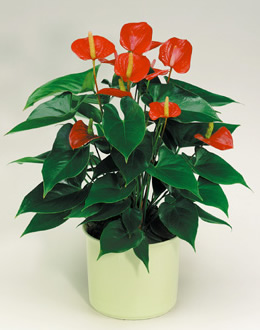
|
The stems are short to elongate with a length between 15 and 30 cm. The simple leaves come in many shapes. Most leaves are to be found at the end of the stem. They may be erect or spreading in a rosette, with a length up to 40 cm. The leaves are petiolate. In drier environments, the leaves can take a bird's-nest-shape rosette that enables the plant to collect water. Terrestrials or epiphytes usually have cordate leaves. Some grow as vines with rosettes of lanceolate leaves. Some species have many-lobed leaves.
|

The flowers are small (about 3 mm) and develop crowded in a spike with a fleshy axis and called a spadix, a characteristic of the arums. This spadix can take on many forms (club-shaped, tapered, spiraled, and globe-shaped) and colors (white, green, purple, red, pink, or a combination).


Usually just below the flower spike lies a colorful, solitary spathe: a showy modified bract that can be somewhat leathery in texture. The spathe can vary in color from pale green to white, rose, orange or shiny red (such as A. andrenaum). The color changes between the bud stage and the anthesis, (the time the flower expands). Thus the color might change from pale green to reddish purple to reddish brown.
The flowers are hermaphrodite, containing male and female flowers. The fruits are usually berries with one to multiple seeds on a pendent infructescence.
The flowers of Anthurium give off a variety of fragrances, each attracting a variety of specific pollinators.

